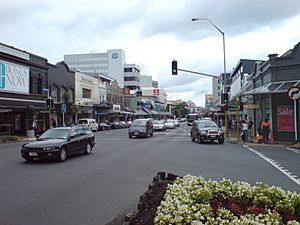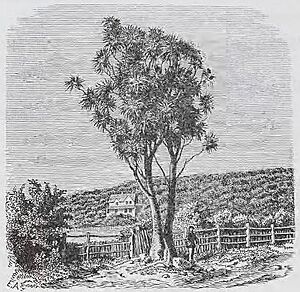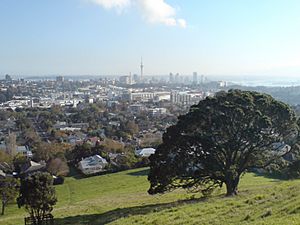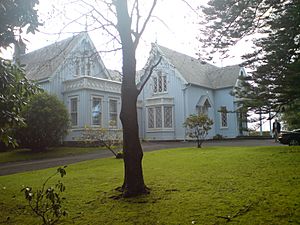Newmarket, New Zealand facts for kids
Quick facts for kids
Newmarket
|
|
|---|---|
|
Suburb
|
|

Broadway, the main street of Newmarket.
|
|
| Country | New Zealand |
| Local authority | Auckland |
| Electoral ward | Ōrākei ward |
| Local board | Waitematā Local Board |
| Established | 1840s |
| Area | |
| • Land | 85 ha (210 acre) |
| Population
(June 2023)
|
|
| • Total | 2,680 |
| Train station(s) | Newmarket railway station |
|
|
||
Newmarket (in Māori, Te Tī Tūtahi) is a busy part of Auckland, New Zealand. It's located southeast of the city centre. Newmarket is famous for its many shops and buildings. It's known as one of New Zealand's best shopping areas. Some even say it's a rival to Auckland CBD, the main city centre.
Newmarket was called a "suburb" of Auckland as early as 1873. But for a long time, it was its own town. It had its own local government, the Newmarket Borough Council, and its own mayor. This lasted until 1989 when it joined the Auckland City Council. Even though it was small, Newmarket was always very busy.
Broadway is the main street in Newmarket. It has large shopping centres and over 400 smaller shops. You can also find two movie theatres there. Plus, there are many restaurants, bars, and cafés.
Contents
Newmarket's Past: A Journey Through Time
Māori History: The Lonely Cabbage Tree
The local Māori people, called Tāmaki Māori, had a special name for this area. They called it Te Tī Tūtahi. This means 'the cabbage tree standing alone' or 'the cabbage tree of singular importance'. It referred to a very important cabbage tree. This tree stood at the corner of Mortimer Pass and Broadway until 1908.
Some cabbage trees in Newmarket today are related to this original tree. A man named Alfred Buckland saved parts of it. He replanted trees around Newmarket and even as far as Bucklands Beach.
There was also a sacred spring in the area. It was near Nuffield Street and Mahuru Street. This spring was called Mahuru Spring. Mahuru is the Māori word for the season of spring. Today, you can't see any signs of this spring.
European Settlers Arrive
The first land in Newmarket was divided up in June 1841. In 1842, Epsom Road was built. It went from the bottom of town through Parnell. This road was later called Manukau Road, then Parnell Road. Newmarket's location was important. It was where several major roads to the east and south began. This included Great South Road. This made Newmarket a key transport hub. It was known as the "Gateway to the South."
In 1845, Khyber Pass Road was built. The place where these three roads met was called "Hobson's Bridge." This was named after a small wooden bridge. The bridge crossed "Hobson's creek." This creek was roughly where the railway tracks are now, near the Olympic Swimming Pool. A small bridge being the main landmark shows how empty the area was back then.
Around 1851, the area got its name, Newmarket. This was because it became the site of the 'New Market' for livestock. Farmers would bring their animals from Manukau, Great South, or Remuera Roads. This market was in a better spot than the older one in Auckland. The Newmarket railway station also helped. It opened in 1873 after the first Parnell Tunnel was finished. The market was south of Remuera Road and east of Manukau Road.
Overlooking Newmarket, on a hill to the southeast, is Highwic. This is a 19th-century wooden house built in the Gothic style. It was the home of Alfred Buckland, a local businessman. Today, Auckland Council owns Highwic. Heritage New Zealand looks after it. Another piece of land owned by Alfred Buckland is still called "Bucklands Beach."
A Thriving Suburb Grows
Newmarket's main road is called Broadway. It used to be Manukau Road. In late 1912, the Newmarket Borough Council renamed it Broadway. They wanted to show it was no longer a muddy street. The Broadway Cinema opened in 1911 as the Adelphi Theatre. It changed its name in early 1915. The cinema was a brick and iron building. It was connected to shops on Broadway. The cinema closed in late 1925. Like its famous New York namesake, Newmarket's Broadway became bright and modern. By the 1960s, it had the most neon signs in New Zealand.
The Olympic Swimming Pool was built in 1939. It was designed by the town's engineer, N. F. Alcock. This Art deco building opened in 1940. It was a great asset for all of Auckland. The Olympic-sized pool hosted many sports events. This included the Empire Games in 1950. Recently, the pool's design changed a lot. A cinema complex was built over the pool. It used to be open to the sky. North of the Olympic Swimming Pools is the Olympic Park War Memorial.
South of the Olympic Pools is Lumsden Green. This park is a triangle of land. It's where Parnell Road, Broadway, and Khyber Pass meet. This land was set aside as a park in 1878. The park has a modern fountain and a 19th-century cannon. It also has a stainless steel sculpture by Marté Szirmay. This sculpture was put there in 1969. It marked 100 years of the Newmarket Highway district. The park is named after David Lumsden. He was the last mayor of Newmarket. This was before it joined Auckland City in 1989.
For most of the 20th century, traffic going in and out of Auckland passed through Newmarket. Remuera Road starts off Broadway. It leads to the eastern suburbs. Further south, Broadway splits into Great South Road and Manukau Road. The constant flow of traffic made Newmarket seem fast and modern. It also helped it become very successful. Around 1966, about 25,000 to 30,000 cars used the street every day.
A big change to the skyline was the Newmarket Viaduct. It was built in 1966. This bridge carried part of the Southern Motorway. It went over the railway and several streets. The new motorway opened up new industrial areas to the south. These included Penrose and Mount Wellington. This caused many local industries to leave Newmarket. Many working-class people who lived nearby also moved away.
Since the 1960s, Newmarket has mostly been a shopping area. But some light industry still existed. The most important was beer brewing. Since the 1840s, Newmarket has had several breweries. Water from nearby Mount Eden flows into springs in the Khyber Pass area. This water is filtered by volcanic rock. The brewery buildings on Khyber Pass Road were taken down in 2014. The land is now part of the University of Auckland.
In 1994, Burger King opened its first New Zealand store in Newmarket. It was at 80A Broadway. This store closed in 2020.
Newmarket Today: A Modern Hub

Newmarket is now one of New Zealand's top places for shopping and dining. It's also a major entertainment spot. But its location on a main road caused traffic problems. In the mid-2000s, some people felt the council wasn't doing enough. Projects like the Central Connector have helped.
Traffic jams were a big reason for arguments. A plan for a new Westfield Group shopping centre was strongly opposed. The Newmarket Protection Society, made of residents and local businesses, fought against it. Because of these objections, Westfield changed its plans. Instead, they bought the Two Double Seven shopping centre. This centre was greatly redeveloped and expanded from 2017 to 2020.
Traffic is still a major issue in the area. Broadway carries over 40,000 vehicles daily. This makes it hard for shoppers to cross the main road. An earlier plan from 2003 didn't happen. It was to build a "road over rail" above the railway line. This could have greatly reduced traffic on Broadway. However, in the late 2000s, new high-quality bluestone footpaths were added. These were along Broadway and some side streets.
The Auckland Regional Council sees Newmarket as a "strategic managed growth area." This means they want to encourage high-density buildings. These buildings would combine homes and businesses. The goal is to have places where people can work, live, and have fun close by. This reduces the need to travel, especially by car, every day. Good public transport also helps with these goals. More large apartment buildings are now appearing in the area. This is partly due to new planning rules. However, many apartments built in the 2000s were criticized. They were called "shoe boxes" or "rabbit hutches" because they were small and plain.
In 2007, the Lion Brewery announced it would leave Newmarket. It sold its large site north of Khyber Pass Road for NZ$162 million. This area will likely become a mix of homes and businesses. This marks "the end of Newmarket's industrial age." Another industry, Hayes Metal Refineries Ltd, also decided to move in 2008.
In 2012, the Newmarket Business Association started a theatre company. It was called Newmarket Stage Company. This company aimed to use the area's transport, cafes, and restaurants. It operated from The Factory Theatre in Eden St. Their first shows were Educating Rita and Tuesdays With Morrie. Kiwi actor George Henare became the company's patron in 2014.
Newmarket's wireless CCTV system is special. The police and the Newmarket Business Association work together on it. It's been called the first of its kind in a New Zealand town centre. This system has helped reduce some types of crime in Newmarket.
Who Lives in Newmarket? (Demographics)
Newmarket covers about 0.85 square kilometers. It has an estimated population of 2,680 as of June 2023. . This means there are about 3153 people per square kilometer.
Newmarket's population has grown a lot. In 2006, there were 2,262 people. By 2018, it had grown to 3,993 people. This was an increase of 76.5% since 2006.
In 2018, there were 1,608 households. There were more females (2,136) than males (1,854). The average age was 35.2 years. About 10.1% of people were under 15 years old. 28.3% were aged 15 to 29. Most people (45.2%) were aged 30 to 64. About 16.5% were 65 or older.
Newmarket is a very diverse place. In 2018, 49.0% of people were European/Pākehā. 48.5% were Asian. Smaller groups included Māori (2.9%), Pacific peoples (1.5%), and other ethnicities (3.5%). Many people (57.0%) were born overseas. This is much higher than the national average of 27.1%.
When asked about religion, 51.8% said they had no religion. 34.0% were Christian. Other religions included Hindu (2.6%), Buddhist (2.9%), and Muslim (1.4%).
Many people in Newmarket have high levels of education. 48.0% of people aged 15 or older had a bachelor's degree or higher. The average income was $41,700. This was higher than the national average of $31,800. About 49.8% of people aged 15 or older worked full-time.
How Newmarket is Governed
Newmarket used to have its own local government. This was like other towns in Auckland at the time. The Borough of Newmarket was formed on May 7, 1885. Before that, local matters were handled by the Newmarket Highway District and the Newmarket Road Board.
The Newmarket Borough Council joined the Auckland City Council in 1989. Then, in 2010, it became part of the larger Auckland Council. When Newmarket governed itself, it had its own mayor.
Newmarket's Mayors (1885–1989)
Here are the people who served as mayor of Newmarket:
- William John Suiter, 1885–1887
- William Morgan, 1887–1891
- George Kent, 1891–1893
- Federick George Clayton, 1893–1895
- John McIntyre Laxon, 1895–1899
- John McColl, 1899–1904
- Francis Bennett, 1904–1909
- Ernest Hyam Davis, 1909–1911
- David Teed, 1911–1915
- James McColl, 1915–1917
- Christopher Leek, 1917–1921
- Samuel Donaldson, 1921–1944
- Richard Edward Newport, 1944–1944
- Charles Hugh Kay Mountain, 1944–1947
- Frederick Phillpott, 1947–1953
- George Albert Hardley, 1953–1957
- William "Bill" White, 1957–1974
- David Hadley Lumsden, 1974–1989
Newmarket Business Association
The business community has always played a big role in Newmarket's governance. In the early days, farmers, brewers, and shop owners had a strong voice. Some of them became leaders in local boards or the Borough Council.
After the Borough Council closed, the Newmarket Business Association (NBA) took over. The NBA was first formed in 1937. It represents the interests of local businesses. Many issues today, like traffic, roads, and safety, were also important 100 years ago.
In the early 1990s, the NBA joined Auckland Council's Mainstreet funding program. In 1994, they hired their first town centre manager, Sue Gunn. Later managers included Robin Winter, Cameron Brewer (2005-2010), Ashley Church (2010-2014), and Mark Knoff-Thomas (2014-present).
Auckland Council also started the Business Improvement District (BID) Programme. The NBA became part of this program. Businesses in the defined BID area pay a special rate. The council collects this money. Then it gives a grant to the NBA to fund its work.
Today, the NBA has a team of 11 people. They focus on supporting businesses. They also work on marketing, arts, heritage, and security for Newmarket.
Schools in Newmarket
Newmarket has a primary school called Newmarket School. It's for students in years 1-6. It has a roll of 268 students as of February 2024. .
The Senior Campus of ACG Parnell College is also located in Newmarket.
Newmarket's Railway Story
Newmarket was once a very important place for railways. It grew a lot after the train line from the city opened in 1873. It had a junction station, two signal boxes, and two railway workshop areas. There were also railway houses and a social hall.
This changed in 1930 when the Newmarket Workshops closed. Their work moved to the Otahuhu Workshops. The workshops near Broadway were torn down. The workshops along Middleton Road were given to the New Zealand Post Office. They were used for Post Office workshops until the mid-1990s.
In the 1980s, the Newmarket Railway Social Hall and other railway buildings were demolished. By 1995, not much was left of Newmarket's railway past. Only the Fine Station, which closed in 1983, and its signal box remained. The signal box was one of the last in New Zealand to use old-style levers. The old workshop buildings on Middleton Road were also torn down that year.
By the 21st century, very little of Newmarket's railway history remained. Only the station and the signal box were left.
In 2008, work began on a new railway station. It was part of the Auckland Regional Transport Authority's plan. This plan was to upgrade train stations across the city. The new station opened on January 14, 2010. It is the second busiest station in Auckland, after Britomart.
Important Buildings in Newmarket
Newmarket has lost many of its old buildings due to new developments. But some important ones remain.
- Highwic (around 1863): This is the old home of Alfred Buckland. It's still standing and open to the public. It's known as one of Auckland's most important historic houses. It was built in the Carpenter Gothic style.
- Junction Hotel (1850s): This hotel was at the corner of Broadway, Great South, and Manukau Roads. It has been demolished.
- Newmarket Hotel (1850s, rebuilt 1920s): This hotel was at the corner of Broadway and Morrow St. It has been demolished.
- St Georges Hotel (1880s): This hotel was on Broadway, across from Khyber Pass. It has been demolished.
- Carlton Club (1890s): This building is at the corner of Broadway and Khyber Pass Road. It is still standing.
- Former Newmarket Manual Training School (1903): This school was moved to Seccombes Rd in 1925.
- Captain Cook Brewery (1870s - 1920s): This brewery was on Khyber Pass Road. It has been demolished.
- Newmarket Borough Council Chambers (1920s): This building was on Broadway. It has been demolished.
- Former Post Office (1910): This building was on Broadway. It was designed by John Campbell. It has been changed over time.
- Rialto Picture Theatre (1920s): This theatre was on Broadway. It was designed by Keith Draffin. It has been changed.
- St Peter's College and Christian Brothers House (1939–1944): This school was designed by William Henry Gummer. It is still standing.
- Former Auckland Electric Power Board Building (1949): This building is on Remuera Road. It was designed by Lew Piper. An extra floor was added in 1964. It is still standing.
- Newmarket Train Station building (1908): This building was designed by George Troup. It is still standing but has been moved and refurbished. It is now at Parnell station.
- Former Jubilee Institute for the Blind (1907): This building was designed by Edward Bartley. It is on Parnell Road and is now the Parnell Public Library.
- Olympic Swimming Pool (1939): This pool was designed by N.F Alcock. It is on Parnell Road. It has been greatly changed and is now covered by a cinema and car park.
Images for kids
-
Newmarket from Maungawhau / Mount Eden looking northeast.







